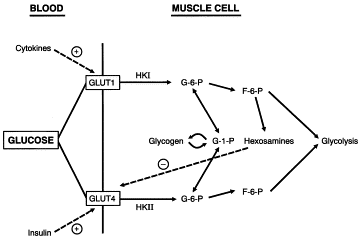They injected peeps with Somatostatin at the Phoenix Indian Hospital in Arizona to activate the GLUT1 pathway.
Somatostatin suppresses insulin and glucagon, but you would not want to mess with that stuff, if you don’t know what your doing.
Somatostatin is produced by the pancrease.
What is really crazy about what I posted above is that hexosamines are a type of amino sugar.
Something like a table sugar IV is used to disable or neutralize e.g. ammonia poisoning?
What is even more suspicious is that the research in this area is like rare or non-existent? (conspiracy theories are running through my head at great speeds at this point i.e. population control?)
A further in depth observation is that the alkalinic prostatic fluid of males smells like ammonia (a bleachy type odor) but is a sugar that powers the tail of the sperm and inside the head of the spermatozoon is the mitochondria which I imagine is generating lots of ATP and phosphorylation (subatomic nuclear radiation[4])? (example of cross comparison on mitochondrial burning or oxidation of glucose, amino acids and fatty acids)
Footnotes:
[1] Hexosamines are amino sugars created by adding an amine group to a hexose.
Examples include:
[2] AMMONIA AND BLOOD SUGAR: …Similar results were obtained when ammonia was added to an aqueous solution of glucose dissolved in an aqueous phosphate mixture of pH = 7.40.” These suggestive findings led us to study the effect of ammonia on blood sugar in vivo as well as the effect of glucose on blood urea in vitro. …” …More
[3] “…August 7, 1965: A new imidazole compound was isolated as crystalline form from the reaction mixture of glucose and ammonia, and identified as 4(5)-(DL-glycero-2,3-dihydroxypropyl)imidazole. From the results the authors suggested that pentose may be formed in the reaction mixture not by direct fission of C-C bond of glucose but by recombination of glucose fragments, for example, of triose and glycolic aldehyde. 4(5)-[D-(-)-Glycero-2,3 dihydroxypropyl]imidazole was also newly prepared from D-xylose via 3-deoxy-D pentosone. …” …More
[4] “…When in vitro DNA in test tubes was exposed to coherent laser light, the laser light spiralled along the DNA helix as if it was guided by the structure of the DNA molecule. The most amazing effect was noticed when the DNA itself was removed and the laser light kept spiralling! The vacuum of the space that was just previously occupied by the DNA had changed and something caused the laser light to keep spiralling. These effects have been measured and remained for quite some time after the DNA was removed. The effect is now becoming well known as the DNA phantom effect. …” …More

